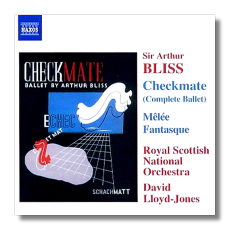
The Internet's Premier Classical Music Source
Related Links
- Latest Reviews
- More Reviews
-
By Composer
-
Collections
DVD & Blu-ray
Books
Concert Reviews
Articles/Interviews
Software
Audio
Search Amazon
Recommended Links
Site News
 CD Review
CD Review
Arthur Bliss

Ballets
- Checkmate
- Mêlée Fantasque
Royal Scottish National Orchestra/David Lloyd-Jones
Naxos 8.557641 DDD 65:03
Games lend themselves well to the ballet. Debussy's inspiration for Jeux was tennis, and Stravinsky's Jeux de cartes (Card Game) is a ballet "in three deals." Sir Arthur Bliss' 1937 ballet Checkmate is based on chess, of course. The 50-some minute ballet follows the course of a chess match, with all of the pieces represented on stage by dancers. (In the Prologue, it is established that the match is a contest between the allegorical figures of Love and Death.) The game ends when the treacherous Black Queen "kills" the ineffectual Red King. Bliss wrote Checkmate for the Vic-Wells Ballet, and the original dancers included Frederick Ashton (Death), Robert Helpmann (Red King), June Brae (Black Queen), and, leading the Black Pawns, Margot Fonteyn. The choreographer was Dame Ninette de Valois, born in Ireland, christened Edris Stannus, and better known as "Madam." (At the time of Checkmate, she did not know how to play chess!)
As befits the subject, there are few moments of repose in Bliss's score; something is always going on. The music is warlike rather than heroic, and there is none of the languid romance and spectacle one associates with ballets from the previous century. In 1937, it was impossible to ignore what was going on in Germany, and it is not unlikely that Bliss was imitating Nazi militarism, even goose-stepping – familiar to all through newsreels – in parts of the score. "Entry of the Red Castles" reuses music Bliss composed earlier for Things to Come, a film which also obliquely anticipates the war. Bliss's score is exciting and masculine. Not even the Red Queen gets much of an opportunity to "unsex" herself.
Usually, recordings of the score cut it down to a suite of five dances. Then, in 2001, Barry Wordsworth made the first recording of the complete ballet, conducting the Royal Ballet Sinfonia for the Academy Sound &Vision label (CDWLS255). This new Naxos disc is the second complete recording. It is preferable to AS&V's on several counts. First of all, AS&V's release is on two discs ("Tribute to Madam"), and includes the scores to three other ballets choreographed by de Valois. These are interesting enough, but there's no need to buy two CDs if all you want is Checkmate. Furthermore, the Royal Scottish National Orchestra outplays the Royal Ballet Sinfonia. David Lloyd-Jones chooses slower tempos than Wordsworth, giving the score a more brutal power. Last but not least, Naxos' engineering is fuller than AS&V's.
Naxos' coupling is Mêlée Fantasque, written in 1921, and Bliss's first orchestral score. (Inspired by the Ballets Russes, he referred to it as his first ballet score, but I don't think it was used as such.) Bliss wrote it in memory of a friend who had been an artist and theater designer. The composer intended "to convey the rhythmic verve and Bakst-like colour of Lovat Fraser's paintings." A few relatively reflective passages remind us that this is a memorial work, but "rhythmic verve" and "Bakst-like colour" dominate the Mêlée Fantasque. As in Checkmate, the performance and the engineering are excellent!
Copyright © 2005, Raymond Tuttle




















